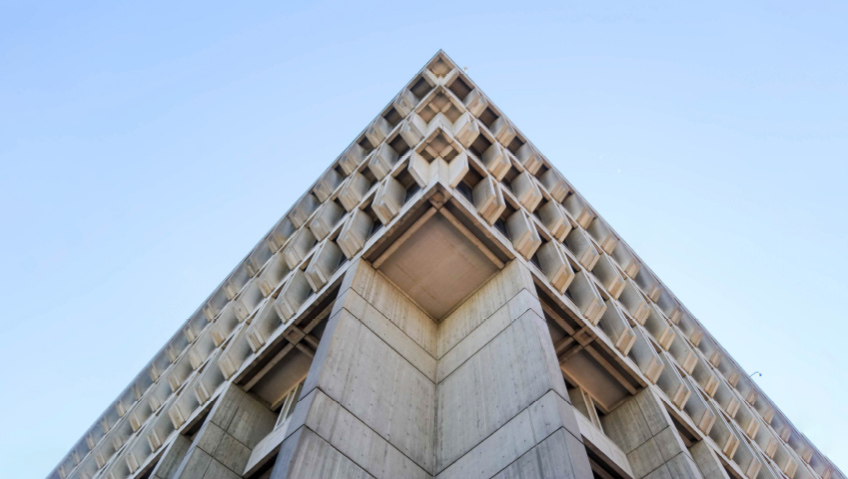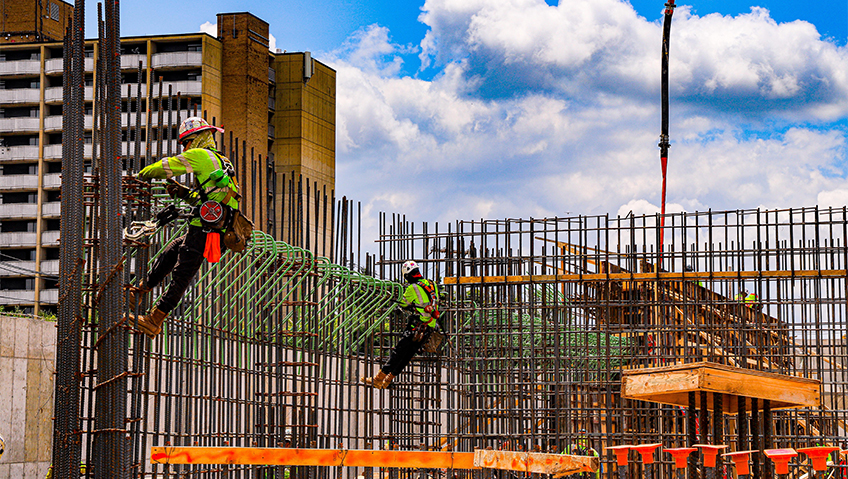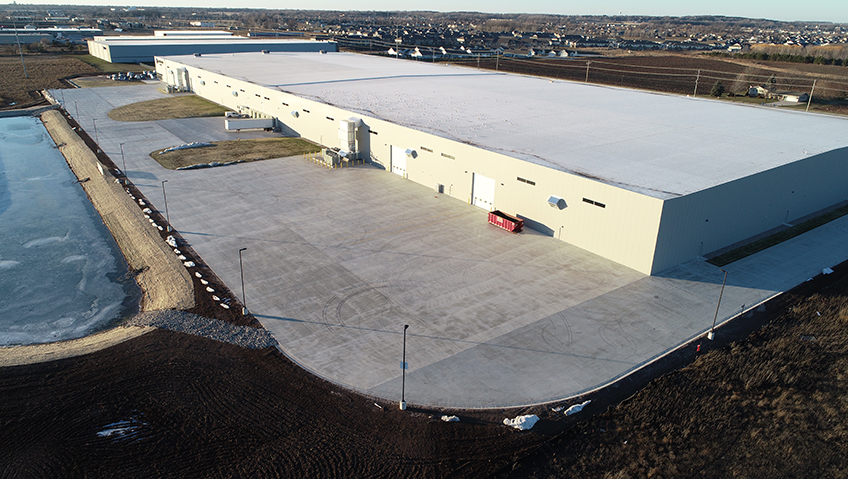“The philosophy behind brutalist architecture is rooted in the belief that architectural design should prioritize functionality, honesty, and social purpose.”
-Mark Bittoni, Bittoni Architects
Love it or hate it—and the divisive reaction is strong—brutalist architecture remains one of the most contentious architectural movements of the modern era, frequently evoking strong feelings of both like and dislike. Brutalist architects promoted socialist utopian ideals which were often linked to the style, along with its simple and stripped bare aesthetic of unpainted concrete or brick, along with steel, timber, and glass. Emerging in the 1950s after the second World War with simple structures many claimed were meant to house and provide shelter, brutalism particularly featured the recycling of concrete materials, which was one of the driving forces behind the movement. In fact, the word brutalism comes from the French “béton brut,” meaning “raw concrete.”
In keeping with the modernist movement, which placed a strong emphasis on removing superfluous decoration, brutalism completely eliminated ornamentation, eliciting strong public opposition as it was considered an unsightly eyesore on the landscape, according to Aotea (www.aoteamade.co.nz/blogs/journal/saving-concrete-a-look-at-brutalist-architecture).
Detractors often argue that the harsh, unvarnished appearance of brutalism is linked to a lack of insight and inventiveness, with brutalist buildings often portrayed as ugly blocks of university and college campuses that seem to be abandoned or in disuse, or depressing apartments with poor architectural design.
But brutalist structures aren’t inherently disliked. According to Aotea, students adore the numerous brutalist or semi-brutalist residential buildings at the University of North Carolina, as well as the university’s two brutalist libraries—one brick and one concrete.
Designed to boldly go against the grain and permanently alter cityscapes and skylines around the globe, the fundamental characteristics of brutalism architecture include unreserved use of raw concrete, geometric shapes, and an unwavering dedication to practicality, according to Indovance (www.indovance.com/knowledge-center/brutalism-architecture-a-bold-approach-to-building-design/), and while some may find its starkness inspiring, others consider it an acquired taste. However, the distinct charm of brutalist architecture is what made it so well-known in the 20th century. Recognized for celebrating unapologetically exposed structural features, its design helped cement its reputation as a movement that upholds the inherent beauty of unusual materials and unwavering functionality.
Gaining popularity through the 1970s as a living example of how raw concrete can transform a space, brutalism is a very different architectural style from the elaborate ones that came before. Centred on embracing exposed concrete in its most unadulterated state, brutalist architects championed an unapologetic, raw beauty in urban construction, emerging as a reaction against earlier ornate and decorative architectural styles. French-Swiss architect Le Corbusier is credited with giving rise to the movement, says Architecture Courses (www.architecturecourses.org/learn/distinctive-characteristics-brutalist-architecture), with one of his greatest works of art, la Cité radieuse in Marseille, regarded by many as the first instance of brutalist architecture. Concrete’s natural strength and durability convinced Le Corbusier it was the best material for creating contemporary cities with buildings that emit strength, simplicity, and order that naturally weather over time.
Designed with purpose in mind, brutalism’s practicality puts function and utility first, and while they look imposing, the buildings frequently mesh well with their natural surroundings by incorporating landscaping and green areas that permit architects to create a symbiotic relationship between structures and surroundings, making often harsh concrete landscapes more serene via integration with nature.
While there are many examples of brutalist architecture around the world, one of the most famous is Montreal’s Habitat 67 designed by Moshe Safdie, which subverts preconceived ideas about what it means to live in an urban setting by assembling modular concrete units in an eye-catching, asymmetrical pattern. Every apartment has a private terrace, and the buildings’ connections foster a feeling of neighbourhood among the concrete surroundings. Hugely famous and widely regarded as the shape of things to come according to Curbed when it made its debut at the Expo ‘67 World’s Fair, the apartment complex is made up of 354 prefabricated concrete modules that are stacked over a total of 12 stories in different configurations along with elevated walkways and rooftop gardens. Safdie intended for Habitat 67 apartments to provide seclusion and outdoor living areas in addition to promoting a feeling of community, and the design has influenced construction projects around the world, according to Architecture Courses, including the Barbican Centre in London, which is home to a theatre, concert hall, art gallery, and residential buildings, and is proof of how versatile brutalist architecture can be in areas with multiple uses, with concrete towers and elevated walkways creating a distinctive urban ecosystem that combines living, culture, and nature.
Boston City Hall, created by the architects Kallmann, McKinnell, and Knowles, is considered a controversial example of American brutalism with its stark, angular façades and excessive concrete, representing the movement’s dedication to functionalism in public structures, while The National Theatre located on London’s South Bank is a well-known landmark on the Thames River, featuring exposed concrete surfaces, connected terraces, and dramatic fly towers. Since its founding in 1976, the National Theatre has served as a focal point for the performing arts in the United Kingdom.
The Geisel Library in San Diego features striking concrete structure and sharp angles, plus a library with an extensive Dr. Seuss collection. Cameron Offices in Canberra, Australia, designed by John Andrews and completed in 1972, is a prime example of the global reach of brutalism, despite having been partially demolished. Built on a six-acre site, this government complex features precast concrete and repeating geometric forms, providing housing for about 4,000 public servants and demonstrating brutalism’s lasting impact outside of Europe.
Even if you don’t personally care for brutalism, there’s no denying its influence on modern architecture, particularly its practicality, which continues to inspire many modern architects who incorporate its ideas into their creations. The movement’s emphasis on exposed materials, geometric purity, and functionalism has had a lasting impact on the architectural community.
In fact, according to Architecture Courses, there’s a growing appreciation for the historical and architectural significance of brutalist buildings as they age. In order to maintain these buildings as an essential component of our urban fabric, preservation efforts are being carried out to safeguard and repair them. Because of their cultural significance, organizations and enthusiasts are putting forth endless effort to preserve brutalist landmarks for future generations as their audacious, unapologetic designs have irrevocably altered urban environments all over the world, upending preconceived ideas about what is beautiful and useful.
The distinctive qualities and goals of brutalist architecture are still valued today, which inspires architects and urban planners to reconsider how to plan, develop, and design cities with a focus on geometry, concrete, and functionality. And while architectural styles will never be loved and appreciated by everyone, brutalism is a truly unique and immediately recognizable medium of artistic expression that inspires a strong reaction. Despite an evolution of construction from brutalism to more elegant buildings that exhibit architectural grandeur and are filled with sustainable features that reflect modern demands, brutalism’s utilization of nature and practicality are still useful today, particularly during ongoing housing crises and climate concerns.
Despite being a relatively short-lived movement in architecture, brutalist supporters contend it’s an expression of unadulterated realism and an architectural power move. Whether you admire its distinct, potent, and raw aesthetic or scoff at its lack of pattern or colour and its ominous appearance of massive concrete blocks with blank façades, there’s no denying its long-lasting impact, with its unique aesthetics and unwavering approach to design that push society to appreciate the utilitarian as art, find elegance in the unpolished, and see beauty in the unusual.






